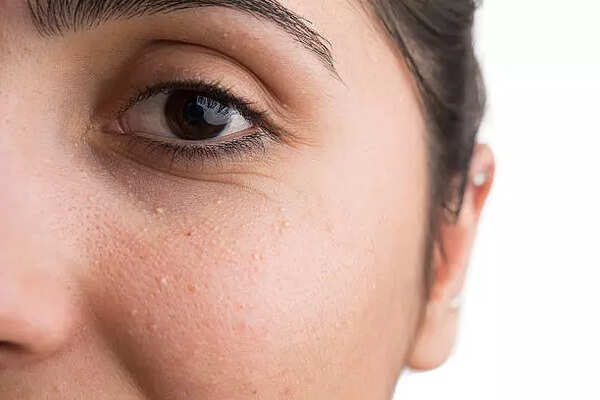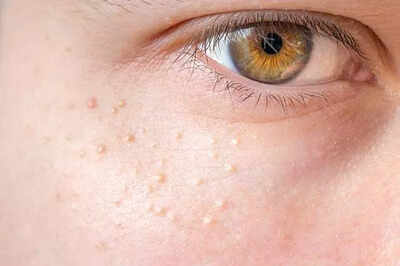Table of Contents
We have all been there: you’re going about your day when you catch a glimpse of your face in the mirror and spot tiny white bumps dotting your cheeks, forehead, or around your eyes. They’re not quite pimples, not exactly blackheads, just stubborn little white dots that don’t seem to go away. So, what are they?

These white bumps are typically milia, though other skin conditions like closed comedones, sebaceous hyperplasia, or even keratosis pilaris can sometimes look similar. Understanding the type of bump is key to treating it effectively and preventing further breakouts. Let’s decode these tiny intruders one by one.
Milia: The most common culprit
Milia (singular: milium) are small, white, keratin-filled cysts that form just under the surface of the skin. They’re especially common around the eyes, nose, cheeks, and forehead. Unlike acne, milia aren’t caused by bacteria or clogged pores due to oil or dirt. Instead, they form when dead skin cells get trapped in small pockets on the skin’s surface.
Who gets milia?
Anyone can develop milia, newborns often have them, but they typically disappear within weeks. In adults, milia can occur due to sun damage, skin trauma, use of heavy skincare products, or simply genetics.
How do you treat it?
While tempting, don’t try to pop them. Milia don’t have an opening to the surface like pimples do, so squeezing can lead to scarring or infection. Instead, gentle exfoliation with ingredients like alpha hydroxy acids (AHAs) or retinoids can help. In stubborn cases, a dermatologist can safely extract them using a sterile needle.
Closed comedones: Early-stage acne
Another common type of white bump is a closed comedone, often referred to as a whitehead. These form when sebum (oil), bacteria, and dead skin cells become trapped in a pore. Unlike open comedones (blackheads), they remain sealed under the skin, appearing as small white or flesh-coloured bumps.
Key differences from milia
Closed comedones are more likely to be associated with oily skin and acne-prone areas like the T-zone. They may eventually become inflamed or develop into full-blown pimples if not treated.
How to manage them
Use products with salicylic acid (a beta hydroxy acid) to help unclog pores, and benzoyl peroxide to target acne-causing bacteria. Consistency is key, and a non-comedogenic skincare routine is crucial.
Sebaceous hyperplasia: Enlarged oil glands
Sebaceous hyperplasia appears as small, soft, yellowish or white bumps, often with a central depression. These occur when the sebaceous glands — responsible for producing oil — become enlarged. They’re more common in middle-aged or older adults and are typically seen on oily skin.
How to identify it
Unlike milia or whiteheads, sebaceous hyperplasia bumps feel a bit softer and may look like small doughnuts under the skin. They’re usually painless and persistent.
Treatment options
They’re harmless but can be removed for cosmetic reasons. Dermatologists may use laser therapy, cryotherapy, or electrocautery to remove them. Topical retinoids can help reduce their appearance over time.
Keratosis pilaris: The ‘chicken skin’ texture
If the white bumps are on your cheeks, upper arms, or thighs, and feel rough like sandpaper, you may be dealing with keratosis pilaris. This is a common and harmless condition where keratin (a protein found in skin) builds up and blocks hair follicles.
What causes it?
It often runs in families and is more prevalent in people with dry skin, eczema, or asthma. It’s particularly common in colder months when skin tends to be drier.
What helps?
Moisturisers containing urea, lactic acid, or glycolic acid can soften and smooth the skin. Gentle exfoliation also helps, but be cautious not to overdo it, scrubbing too hard can irritate the skin and make the condition worse.
When to see a dermatologist
Most white bumps are harmless, but if they multiply rapidly, change in appearance, or become irritated, it’s best to consult a dermatologist. In rare cases, what appears to be a benign bump may be a sign of an underlying condition such as basal cell carcinoma, especially if it’s growing or crusting.

Also, if at-home treatments haven’t worked after a few weeks, a dermatologist can recommend tailored solutions, including prescription retinoids, professional extractions, or laser treatments.
Preventing white bumps in the first place
While not all causes are preventable (hello, genetics!), there are steps you can take to reduce the likelihood of white bumps forming:
Use non-comedogenic skincare products – especially around the eyes and T-zone.
Gently exfoliate once or twice a week using chemical exfoliants.
Avoid heavy creams if you have oily or acne-prone skin.
Protect your skin from sun damage, which can worsen or trigger certain types of white bumps.
Stay hydrated and maintain a balanced diet – your skin reflects what’s happening internally too.
White bumps on your face might be annoying, but they’re usually harmless and treatable. Whether it’s milia, whiteheads, or something else, understanding the root cause is your first step to smooth, clear skin. Be gentle, be consistent, and when in doubt, leave it to the professionals. After all, skin health is a journey and bumps along the way are completely normal.


